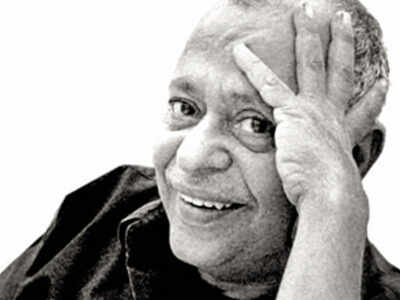
NEW DELHI: Dilli Haat, Garden of Five Senses and State Emporia Complex are landmarks that have become the heart of Delhi’s socio-cultural life. On Sunday, the country lost their creator, Pradeep Sachdeva, whose admirers say a man who articulated a uniquely Indian idea of public spaces had left the shores. Deputy chief minister Manish Sisodia recalled meeting him a few times for different projects and marvelled at how Sachdeva’s work was simple like the man himself. “What is truly remarkable is how he brought alive those public spaces,” said Sisodia. “His imaginative design sense harmonised ecology, aesthetics and sociology – that's the legacy he has left behind.”
Urban planner AGK Menon, founding member of Intach Delhi Chapter and Sachdeva’s friend, said that the late architect had focused on things that the world has only started noticing after this humanitarian crisis. “His model was indigenous and involved local artisans and craftspeople. Look at Dilli Haat, for instance. It’s a bazaar. When others were talking about malls, he was making a bazaar,” Menon said. He added that Dilli Haat showed Sachdeva “could turn a high-end, expensive project into one that stuck to local sensibilities”.
He also said, “As for his streetscaping projects, Sachdeva focused on pedestrians, on non-motorised transport. He accommodated street vendors when the popular opinion was to throw them out for being eyesores, hampering the effort to make Delhi a world-class city.”
Sachdeva’s colleague at Intach, historian Swapna Liddle, agreed. “His designs for public spaces reveal a great sensitivity to what makes for quality of life in an urban setting,” Liddle said, while recalling that he was a “warm and friendly person”.
Being warm and friendly helped in his work too. As Menon revealed, “I strongly disagreed with him on the Chandni Chowk redevelopment and accused him of having no understanding of heritage. I told him that he knew India but not history. We went to court on this, but we met like friends outside. Because he had it in him to accommodate differences and to hear a dissenting opinion, he was able to make modifications and turn it into a better project.”
London-based architect Guntej Bhushan worked with Sachdeva’s firm, PSDA, for four years, including on the Garden of Five Senses project and some hotels. “He was very hands-on. Rather than relying on landscape designers, he put in the effort and time to learn landscaping so that his building designs and landscape would work perfectly together,” said Bhushan.
Harish Sachdeva had the late architect as his thesis supervisor in college. “I later joined him as a junior architect. For two-and-a-half years, I assisted him in building Institute of Social Sciences on Nelson Mandela Marg,” said Harish. “Actually, Pradeep was the local resource, the main architect being Christopher Benninger of Pune. Working with a government department was not easy and they had their own empanelled contractors who used only certain materials. I watched Pradeep use his affability and patience to get a creative output despite such bottlenecks.”
Dilli Haat is the most well-known of Sachdeva’s creations. In a statement on Monday, Delhi Tourism, for whom Dilli Haat was set up, said, “It fascinated Prince Charles so much that he stretched his whistle-stop visit in 2003 to an hour-and-a-half-long fiesta and desired to put up a similar Haat in London. A Dilli Haat exposition was organised at Trafalgar Square in London in association with ministry of tourism in June 2005.” Sachdeva also worked on projects to redevelop the Godavari and Brahmaputra riverfronts and Assi Ghat in Varanasi.
Urban planner AGK Menon, founding member of Intach Delhi Chapter and Sachdeva’s friend, said that the late architect had focused on things that the world has only started noticing after this humanitarian crisis. “His model was indigenous and involved local artisans and craftspeople. Look at Dilli Haat, for instance. It’s a bazaar. When others were talking about malls, he was making a bazaar,” Menon said. He added that Dilli Haat showed Sachdeva “could turn a high-end, expensive project into one that stuck to local sensibilities”.
He also said, “As for his streetscaping projects, Sachdeva focused on pedestrians, on non-motorised transport. He accommodated street vendors when the popular opinion was to throw them out for being eyesores, hampering the effort to make Delhi a world-class city.”
Sachdeva’s colleague at Intach, historian Swapna Liddle, agreed. “His designs for public spaces reveal a great sensitivity to what makes for quality of life in an urban setting,” Liddle said, while recalling that he was a “warm and friendly person”.
Being warm and friendly helped in his work too. As Menon revealed, “I strongly disagreed with him on the Chandni Chowk redevelopment and accused him of having no understanding of heritage. I told him that he knew India but not history. We went to court on this, but we met like friends outside. Because he had it in him to accommodate differences and to hear a dissenting opinion, he was able to make modifications and turn it into a better project.”
London-based architect Guntej Bhushan worked with Sachdeva’s firm, PSDA, for four years, including on the Garden of Five Senses project and some hotels. “He was very hands-on. Rather than relying on landscape designers, he put in the effort and time to learn landscaping so that his building designs and landscape would work perfectly together,” said Bhushan.
Harish Sachdeva had the late architect as his thesis supervisor in college. “I later joined him as a junior architect. For two-and-a-half years, I assisted him in building Institute of Social Sciences on Nelson Mandela Marg,” said Harish. “Actually, Pradeep was the local resource, the main architect being Christopher Benninger of Pune. Working with a government department was not easy and they had their own empanelled contractors who used only certain materials. I watched Pradeep use his affability and patience to get a creative output despite such bottlenecks.”
Dilli Haat is the most well-known of Sachdeva’s creations. In a statement on Monday, Delhi Tourism, for whom Dilli Haat was set up, said, “It fascinated Prince Charles so much that he stretched his whistle-stop visit in 2003 to an hour-and-a-half-long fiesta and desired to put up a similar Haat in London. A Dilli Haat exposition was organised at Trafalgar Square in London in association with ministry of tourism in June 2005.” Sachdeva also worked on projects to redevelop the Godavari and Brahmaputra riverfronts and Assi Ghat in Varanasi.

Coronavirus outbreak
Trending Topics
LATEST VIDEOS
City
 Watch: Video proof of Pak diplomat spying with a decoy sent by the Indian Intelligence Agency
Watch: Video proof of Pak diplomat spying with a decoy sent by the Indian Intelligence Agency  Unlock 1.0: Non-subsidized LPG gas price hiked by Rs 11.50 in Delhi
Unlock 1.0: Non-subsidized LPG gas price hiked by Rs 11.50 in Delhi  Covid-19 crisis and lockdown: Delhi CM Arvind Kejriwal seeks public suggestions
Covid-19 crisis and lockdown: Delhi CM Arvind Kejriwal seeks public suggestions  India unlocks: Guidelines issued to taxi services operating to and from Delhi Airport
India unlocks: Guidelines issued to taxi services operating to and from Delhi Airport
More from TOI
Navbharat Times
Featured Today in Travel
Get the app





